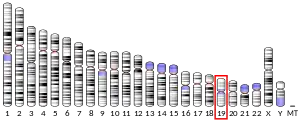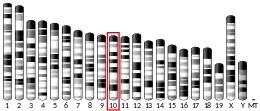CACTIN
CACTIN was originally identified in Drosophila (fruit flies). Cactin gene is responsible for innate immune system responses and acts as negative Toll-like receptor.[1] The full-length cactin protein length is 3,150 bp long and with an N-terminus from 356–547 residues and a domain in the C-terminal 731–855 residues.[2] This protein resides in many organs and tissues of all vertebrates, however, most recently it has also been found in plants, protist, and fungi. The location that is highest in concentration of cactin gene is in the testis of males and in the spleen. The cactin gene in this specific areas like the testis enables RNA binding activity. This protein was also found to be involved in other process like cellular response from cytokines and negative signal transduction (negative feed back loops).[3]
Scientist are still discovering different process that cactin gene is involved in. For instance, biochemist have discovered that the absence of cactin gene will result in gluten allergy, which is in many breads and sweets. Most recently, biochemist have discovered that cactin gene is in both plant and animal cells. In plant the cactcin gene is associated with SR proteins localized in the nucleus, and in many cases the cells form nuclear speckles (speckles structures are not clear amongst biologist yet, more studies need to be done).[4] Plant and human cells share the same spliceosomal proteins, which involved the eradication of introns in order to form messenger RNA, in which cactin gene promotes this process and can also tell it when to stop. In the next decades to come we will uncover more information of the cactin gene with the improvement of technology.
Cactin also known as renal carcinoma antigen NY-REN-24 is a protein that in humans is encoded by the CACTIN gene.[9][10][11]
References
- "CACTIN Gene - GeneCards | CATIN Protein | CATIN Antibody". www.genecards.org. Retrieved 2022-03-03.
- Zhang, Shuang; Shi, Lili; Yang, Qi-Hui; Dong, Xiao-Hui; Chi, Shu-Yan; Liu, Hong-Yu; Tan, Bei-Ping (2014-12-01). "Molecular characterization and functional analysis of Cactin gene from Litopenaeus vannamei". Fish & Shellfish Immunology. 41 (2): 608–617. doi:10.1016/j.fsi.2014.10.014. ISSN 1050-4648.
- "CACTIN cactin, spliceosome C complex subunit [Homo sapiens (human)] - Gene - NCBI". www.ncbi.nlm.nih.gov. Retrieved 2022-04-24.
- Baldwin, Katherine L.; Dinh, Elizabeth M.; Hart, Brian M.; Masson, Patrick H. (2013-04-02). "CACTIN is an essential nuclear protein in Arabidopsis and may be associated with the eukaryotic spliceosome". FEBS Letters. 587 (7): 873–879. doi:10.1016/j.febslet.2013.02.041. ISSN 0014-5793.
- GRCh38: Ensembl release 89: ENSG00000105298 - Ensembl, May 2017
- GRCm38: Ensembl release 89: ENSMUSG00000034889 - Ensembl, May 2017
- "Human PubMed Reference:". National Center for Biotechnology Information, U.S. National Library of Medicine.
- "Mouse PubMed Reference:". National Center for Biotechnology Information, U.S. National Library of Medicine.
- Andersson B, Wentland MA, Ricafrente JY, Liu W, Gibbs RA (Jun 1996). "A "double adaptor" method for improved shotgun library construction". Anal Biochem. 236 (1): 107–13. doi:10.1006/abio.1996.0138. PMID 8619474.
- Yu W, Andersson B, Worley KC, Muzny DM, Ding Y, Liu W, Ricafrente JY, Wentland MA, Lennon G, Gibbs RA (Jun 1997). "Large-scale concatenation cDNA sequencing". Genome Res. 7 (4): 353–8. doi:10.1101/gr.7.4.353. PMC 139146. PMID 9110174.
- "Entrez Gene: C19orf29 chromosome 19 open reading frame 29".
Further reading
- Scanlan MJ, Gordan JD, Williamson B, et al. (1999). "Antigens recognized by autologous antibody in patients with renal-cell carcinoma". Int. J. Cancer. 83 (4): 456–64. doi:10.1002/(SICI)1097-0215(19991112)83:4<456::AID-IJC4>3.0.CO;2-5. PMID 10508479.
- Jurica MS, Licklider LJ, Gygi SR, et al. (2002). "Purification and characterization of native spliceosomes suitable for three-dimensional structural analysis". RNA. 8 (4): 426–39. doi:10.1017/S1355838202021088. PMC 1370266. PMID 11991638.
- Lehner B, Semple JI, Brown SE, et al. (2004). "Analysis of a high-throughput yeast two-hybrid system and its use to predict the function of intracellular proteins encoded within the human MHC class III region". Genomics. 83 (1): 153–67. doi:10.1016/S0888-7543(03)00235-0. PMID 14667819.
- Brandenberger R, Wei H, Zhang S, et al. (2005). "Transcriptome characterization elucidates signaling networks that control human ES cell growth and differentiation". Nat. Biotechnol. 22 (6): 707–16. doi:10.1038/nbt971. PMID 15146197. S2CID 27764390.
- Sogayar MC, Camargo AA, Bettoni F, et al. (2004). "A transcript finishing initiative for closing gaps in the human transcriptome". Genome Res. 14 (7): 1413–23. doi:10.1101/gr.2111304. PMC 442158. PMID 15197164.
- Beausoleil SA, Jedrychowski M, Schwartz D, et al. (2004). "Large-scale characterization of HeLa cell nuclear phosphoproteins". Proc. Natl. Acad. Sci. U.S.A. 101 (33): 12130–5. Bibcode:2004PNAS..10112130B. doi:10.1073/pnas.0404720101. PMC 514446. PMID 15302935.
- Gerhard DS, Wagner L, Feingold EA, et al. (2004). "The status, quality, and expansion of the NIH full-length cDNA project: the Mammalian Gene Collection (MGC)". Genome Res. 14 (10B): 2121–7. doi:10.1101/gr.2596504. PMC 528928. PMID 15489334.



